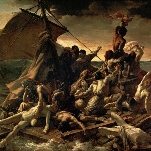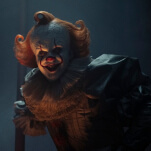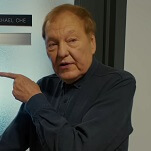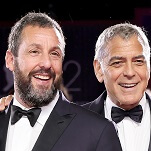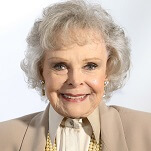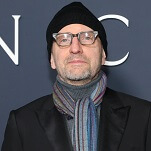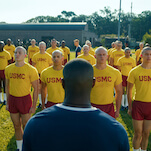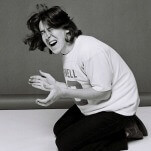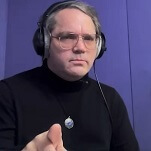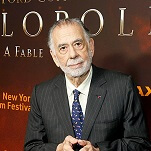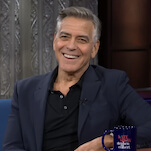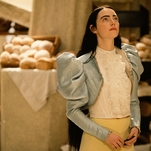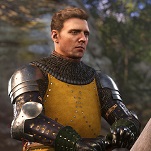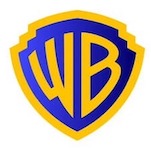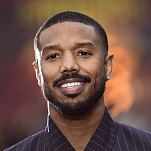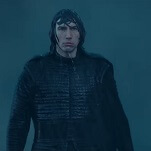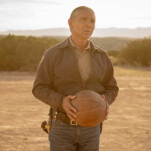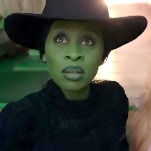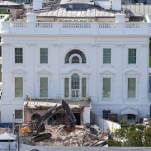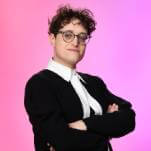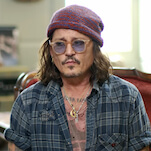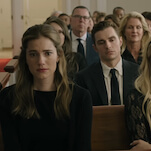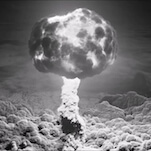26. Eyes Wide Shut (1999)
Years of rumors about how erotic and mind-blowing Stanley Kubrick’s Eyes Wide Shut would be—coupled with the fact that it was Kubrick’s last film, and that its leads were then-megastars Tom Cruise and Nicole Kidman—made it difficult for the movie to get a fair shake back in 1999. But this dreamy, stealthily satirical adaptation of Arthur Schnitzler’s Traumnovelle looks more like one of Kubrick’s best with each passing year. Credit a screenplay by Kubrick and Frederic Raphael that turns Schnitzler’s novel into a psychosexual detective story, with Cruise venturing into a shadowy New York where everyone but him seems to be getting laid. The pace is somnambulant by design, but Eyes Wide Shut’s performances and dialogue are much funnier than they get credit for, and the film contains some of Kubrick’s most striking images—which would make them some of cinema’s most striking, too.
25. Fight Club (1999)
Dazzling, biting, and darkly funny, David Fincher’s Fight Club takes a knife to the empty routine of corporate-dictated, possession-oriented contemporary existence while acknowledging that tossing out the whole system in favor of a new life (and a new personality) isn’t the ideal answer, either. That the film manages to be a sincere shriek of alarm and rage while also being about split personalities, underground fighting rings, and male breast enlargement is itself a miraculous achievement. That Fincher’s visual virtuosity—the splices, the impossibly limber camerawork, the catalog of the narrator’s apartment, and the countless other innovative, memorable bits of style—still looks startlingly fresh is a testament to his place as one of the best directors working today. Fight Club has a beating heart underneath its flamboyantly caustic exterior, one that’s evidenced in an exhilarating, perfectly scored final sequence that showcases the happiest act of massive destruction.
24. Crumb (1994)
When Terry Zwigoff set out to make a documentary about his friend Robert Crumb, he somehow stumbled upon a story even bigger, stranger, and darker than the artist’s transgressive comic books: Crumb’s tumultuous relationship with his brothers Charles and Maxon. Charles and Maxon share Robert’s grim humor (Charles’ favorite phrase was a bitterly sarcastic, “How perfectly goddamned delightful it all is, to be sure”) and penchant for agonizing self-examination, but not his ability to function in the world beyond the most basic level. Crumb is rich in the qualities that define its subject’s work: It’s unrelentingly honest, brutally funny, and almost oppressively dark, but filled with empathy for the suffering of artists too fragile for this rough-and-tumble world. In its own strange way, the film is inspirational. In art, comedy, sex, and engagement with an often scary outside world, Robert finds the gifts that allow him to escape the prison of self that eventually took Charles’ life (he committed suicide in 1993, before the film was released) and continue to trap the even more troubled and tormented Maxon to this day.
23. Carlito’s Way (1993)
Scarface’s phenomenal home-video success gave director Brian De Palma and star Al Pacino the license to revisit the life and times of a criminal kingpin, this time from the perspective of a gangster who’s older and warier. Working from David Koepp’s smartly constructed script—which embeds the antihero’s downfall in nearly every scene, yet still makes him easy to root for—De Palma delivers one of his least ostentatious, most accessible films. But he can’t resist a climactic shootout in Grand Central Station that’s pure De Palma, using train platforms and escalators to illustrate the importance of who sees whom when, and whom they don’t see coming.
22. The Sweet Hereafter (1997)
Russell Banks’ shattering novel about a school-bus accident that robs a town of its children unfolds in a straight chronology, but each chapter is told through the perspective of a different character. A masterpiece of adaptation, Atom Egoyan’s The Sweet Hereafter rearranges the narrative into a puzzle structure that adds an allure of mystery similar to that of Egoyan’s Exotica while laying out the events to maximum impact. (The bus crash, for one, doesn’t occur until well into the second act.) Egoyan deals sensitively with how a town mourns and reconstitutes itself after such a devastating loss while also examining how the legal system is used to assign blame and compensation when no compensation would be sufficient. And in Ian Holm’s performance as a lawyer who tries to represent the families and Sarah Polley’s turn as a crippled survivor, the film goes deep into the complex relationship between parents and children, and how their bond can be severed.
21. Fargo (1995)
The Coen brothers’ first breakout hit crystallizes all their strengths as writers and directors: The diamond-sharp plotting, the unparalleled gift for stylized language (in this case, the quotable dialect of native Minnesotans), the exacting control over every aspect of the production. What makes Fargo special, beyond the Coens working at the peak of their craft, is that it considers the crime thriller in moral terms, turning the bloody mayhem over a scheme gone wrong into a reflection on the bedrock values of home and family. The Coens sharply contrast the desires and temperaments of its two main characters: a car salesman (William H. Macy) who arranges to have his wife kidnapped to bilk ransom money out of his wealthy father-in-law, and a pregnant police chief (Frances McDormand) who waddles her way to the bottom of the case. In McDormand’s steady gumshoe, Fargo has an unforgettable hero who can piece together the clues without comprehending the crime.
[pagebreak]
20. Red (1994)
The last of Krzysztof Kieslowski’s Three Colors trilogy—and the last film the great Polish director made—focuses on the theme of “fraternity,” just as its predecessors focus on different values represented by the French flag. But, as with the other films in the trilogy, each of the values remains in play in a story that explores the unseen connections between citizens of Geneva, particularly a young model (Irene Jacob) and a retired judge (Jean-Louis Trintignant) with a penchant for eavesdropping on his neighbors. In the ’00s, many directors built on the everything-is-connected themes Kieslowski explored throughout the trilogy, and throughout his work in general. But none found a way to build to a moment as overwhelmingly moving as Red’s final scene, a statement of hope for the soul of Europe as it faced a new century of peril and possibility.
19. Exotica (1994)
Undoubtedly the most cerebral movie ever to be set primarily at a strip club, Exotica plays a tantalizing game of “What the hell’s going on here?” with the viewer, parceling out information one outré detail at a time. Why does Bruce Greenwood’s buttoned-down family man order regular lap dances from stripper Mia Kirshner, showing no sign of sexual arousal and leading her through what seems to be some sort of anguished catechism? If Sarah Polley is babysitting every night, why does she appear to be alone in the house, spending all her time practicing the movie’s theme song on the piano? To what purpose does the DJ at the club Exotica, Elias Koteas, keep anonymously taunting Greenwood from the restroom stalls? “We’re here to entertain, not to heal,” insists Exotica’s manager (Arsinée Khanjian), but Atom Egoyan’s bizarro-world take on grief management builds inexorably to a final scene that pieces all of the above together in a powerfully cathartic way, even as it also suggests a new, more disturbing mystery lurking just off-screen (which became the subject of Egoyan’s subsequent film, The Sweet Hereafter). Endless T&A has rarely been employed to such mournful and devastating purpose.
18. Schindler’s List (1993)
There’s no surer way for a cinematic pseud to beef up his or her cred than slagging off Steven Spielberg, especially when the director takes on a subject with the enormity of the Holocaust. But to deride the sentimentality of Schindler’s List, or to criticize Spielberg for telling the story of Jews who survived rather than the millions who did not, is to mistake his carefully judged calculations for mere sugarcoating. (It’s a wonder how Shoah’s Claude Lanzmann, who levied the latter charge, justifies his own Sobibor, an account of the rare instance in which concentration-camp prisoners rose up against their captors. As for Jean-Luc Godard, who accused Spielberg of “reconstructing Auschwitz,” his antipathy for the chosen people is a matter of record.) The scene in which a group of screaming, naked women believe they are being herded to their death, only to find that what they take to be a gas chamber is actually a real shower, leads the audience right up to the line where onscreen characters become simply actors playing dead, leaving the audience fully aware they’ve been let off easy.
17. Safe (1995)
Todd Haynes made his name and reputation with “Superstar: The Karen Carpenter Story,” a notorious and legendary short film that used Barbie dolls to chronicle the pop star’s slow descent and eventual death from anorexia-related complications. A lawsuit from Richard Carpenter and music-licensing issues ensured that the film would never receive an official legal release, but Haynes fruitfully explored similar thematic material with Safe, a quietly terrifying psychological drama that cast a never-better Julianne Moore as a housewife who develops a strange series of maladies that rend her orderly and conformist lifestyle asunder and send her on a desperate journey to identify and cure her illness. Much of what makes Safe so terrifying is its open-ended ambiguity: Moore seems to be allergic not to any specific substance, but rather to the stifling conformity and plastic artificiality of her surroundings. As played by Moore with a heartrending combination of strength and vulnerability, the film’s protagonist is immaculately put-together on the outside but rotting away from incurable soul-sickness on the inside, a victim of a world that pushes her into stifling roles that deny her fundamental humanity and drive her methodically insane.
16. The Big Lebowski (1998)
When the Coen brothers followed up their Academy Award-winning breakthrough hit Fargo (a film deemed “culturally, historically, or aesthetically significant” by no less an authority than the United States National Film Registry) with a shaggy stoner lark about the world’s most unlikely and least qualified would-be shamus (Jeff Bridges as “The Dude,” the signature role of his magnificent career) and his mock-heroic quest to retrieve a missing rug that famously held the whole room together, it felt like one of the smartass brothers’ inside jokes. The film was released to mixed reviews, modest box-office, and widespread confusion before beginning a strange journey to becoming the cult film of the ’90s, the Rocky Horror Picture Show of its time. The Big Lebowski created an entire subculture of tongue-in-cheek “achievers” who dress up like the film’s characters and attend “Lebowski Fests” where they drink white Russians, bowl, and recite favorite lines. Like Bridges’ performance, The Big Lebowski only appears effortless: The slacker facade and shaggy-dog plotting—with its surplus of red herrings, dead ends, and seemingly pointless digressions—belie the film’s underlying meticulousness and manic perfectionism. Slow-motion shots of middle-aged men bowling are choreographed and scored as artfully as anything in Stanley Kubrick’s oeuvre, in a comedy that gave pop culture one of its quintessential antiheroes and created an absurd and insanely detailed universe. Cult movies come and go, but like its hero, The Big Lebowski abides.
15. Groundhog Day (1993)
The very definition of a high-concept Hollywood movie, this Bill Murray vehicle about a vain weatherman stuck reliving the same day could’ve been just another broad, slack comedy. But Murray and writer-director Harold Ramis (working with screenwriter Danny Rubin) invest deeply in their premise, considering all the pros and cons of repetition before setting the hero on a quest to live this one day perfectly. The result is a movie that’s at once hilarious, clever, and surprisingly moving as it considers what it means to “get it right.” Groundhog Day is also one of the last movies where Bill Murray played the “Bill Murray type” he’d popularized in the ’70s and ’80s. He nailed it here; why repeat?
14. Hoop Dreams (1994)
For five years, director Steve James and his crew followed two black teenagers from Chicago who dreamed of becoming professional basketball players. Both kids, William Gates and Arthur Agee, were recruited to play for St. Joseph High School, a predominantly white basketball colossus whose most famous alum is NBA superstar Isiah Thomas. Gates and Agee see the game as their long-shot ticket out of poverty, which amplifies the pressure to succeed and makes every setback, from injuries to academic struggles to conflicts with the coach, seem potentially life-threatening. Hoop Dreams establishes a close relationship with the boys and their families that, over time, reveals the way ordinary people of limited means struggle to stitch up tears in the social fabric. Basketball is a source of hope and delusion, but it’s also just the vehicle for a profound, multi-layered documentary about the pursuit of the elusive American dream.
13. Boogie Nights (1997)
Paul Thomas Anderson was still wearing his influences on his sleeve when he made Boogie Nights, which combines the sprawling ensemble and overlapping narratives of a Robert Altman movie with the juiced-up filmmaking of Martin Scorsese at his most muscular. A story of many lives united by a common profession—pornography—it doubles as a study in changing times and the way even the most underground forms of expression got commodified in the ’80s. But it’s also an old-fashioned Hollywood—well, San Fernando Valley—rise-and-fall story about a kid (Mark Wahlberg) who ascends through the porn industry, lets success go to his head, and risks losing his soul in the process, all shot with breathless momentum and soundtracked to era-appropriate hits that often seem to be telling variations on the same story of innocence lost.
12. Miller’s Crossing (1990)
Miller’s Crossing is a like a dream of a gangster film, one that’s been freed from the normal rules in order to deliver a more concentrated dose of tough guys, dames, mob leaders, and betrayals. The Coen brothers are sometimes dismissed as being arch and emotionally removed when they verge toward pastiche like this, but Miller’s Crossing is far from an exercise in re-creating an old genre with air quotes. The film has a melancholic, poetic soul in Gabriel Byrne, who works to set things right even after his boss and friend Albert Finney casts him out. Byrne may have had a thing with Marcia Gay Harden, but it’s Finney who breaks his heart, and to whom he remains loyal through machinations and murder. The Coens stack their film with unforgettable figures, from John Turturro’s devious Bernie Bernbaum to Jon Polito’s fuming Johnny Caspar, but Finney’s revealed to be the baddest of them all in the incredible action sequence in which he confronts would-be assassins in his bathrobe, undaunted.
11. Barton Fink (1991)
Not Joel and Ethan Coen’s most perfect movie (see the previous entry), Barton Fink is one of their most profound, and painful. It’s also, in retrospect, one of their most personal, the opposing half of A Serious Man’s autobiographical anxiety. John Turturro’s leftist playwright turned Hollywood hack may be modeled on Clifford Odets—whose Sweet Smell Of Success, to be fair, is no Blood, Sweat And Canvas—but he’s more like the Coens’ negative self-portrait, crystallizing their deep-seated distaste for and fear of cinematic pretension. For years, they maintained that their movies were about nothing, that their carefully worked-out symbolism was merely a product of critics’ overactive imaginations, and perhaps the similarity between wallpaper paste oozing from the walls of the Hotel Earle and the pus draining from traveling salesman John Goodman’s infected ear is just a coincidence. But more likely it’s the product of creators so in tune with their collective unconscious that their art surpasses their intent.
Next: Our top 10, featuring a double feature by a single filmmaker. See our first 20 films here, and the outliers and personal favorites that didn't make the list here. Listen to what we have to say about how the decade changed cinema here, and see the '90s films we hate the most here.
